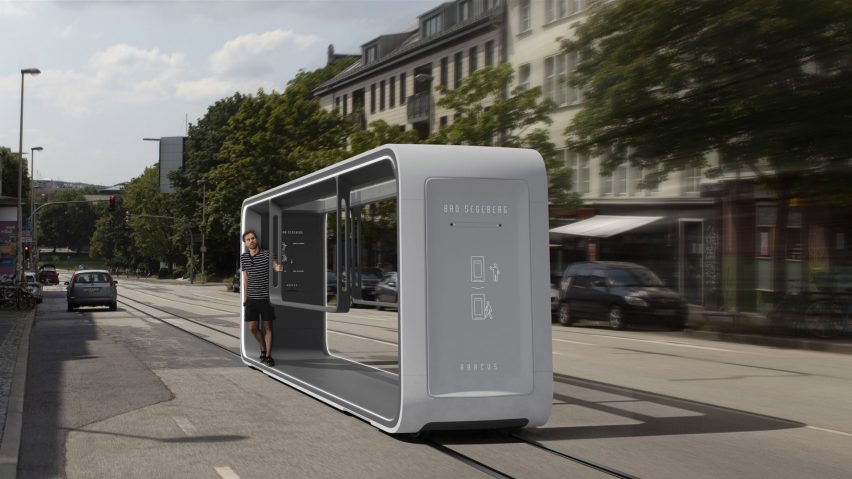The next finalists in Dezeen's Future Mobility Competition powered by Arrival are Lea Haats, Erik Mantz-Hansen and Konstantin Wolf, who have proposed a new electric tram system to run on repurposed railway routes.
Haats, Mantz-Hansen and Wolf's proposal aims to revitalise abandoned infrastructure to improve mobility and connectivity between rural areas and cities in northern Germany.
Called Abacus, the concept aims to reduce commute times, improve village-to-city connections and reduce the need for private transportation.
The Abacus tram is a hop-on, hop-off system, where passengers can hail the tram to a halt through the simple gesture of waving. This signal is recognised by on-board cameras through pattern recognition and causes the vehicle to stop.
The trams are electric to limit emissions and noise pollution and would be powered via rail tracks by induction to negate the need for large batteries and ensure a lighter weight of the vehicle.
The trams are characterised by expansive windows that aim to frame the vistas of surrounding countryside to enhance the passenger's travel experience. The open side of the tram is equipped with hand rails for passengers to lean or sit on.
The low floor enables passengers with mobility issues to easily step on and off the tram, while a retractable ramp can be used to aid wheelchair users.
Read more about the proposal below:
Abacus
Lea Haats, Erik Mantz-Hansen and Konstantin Wolf
Kiel, Germany
Finalist
"A large part of urban traffic is not caused by inner-city routes but is generated from further away. In rural areas, it seems to be very difficult to offer a mobility solution that is more attractive than the private car.
"But in the long term, the number of these inefficient vehicles must be reduced in order to decrease traffic, save space and to achieve the goals of climate protection.
"In our focus area of northern Germany, we have encountered this problem frequently. There is barely any public transportation that provides a reliable connection between each village to the nearest city.
"The total length of Germany's streets excessively outnumber the usable infrastructure of railroads. In the last 100 years, more than half of all rail lines in northern Germany alone have disappeared or been discontinued.
"The revitalisation of [these] tracks has a high potential, not only to reduce traffic and emissions, but also to rebuild a bridge between city and countryside.
"For the Abacus concept, it was crucial that the new track could be used flexibly and reliably enough to keep up with the comfort of the private car. Therefore, the travel distance is concentrated on a relatively short track, so that any point on the route can be reached by the tram in a few minutes.
"The rails run asymmetrically on one side of the track to leave enough space for pedestrians and cyclists. This way, the path itself and the surrounding nature are given central importance."
Future Mobility Competition
The Future Mobility Competition is a global design contest that seeks to support emerging talent, bringing radical solutions to solve mobility challenges in cities and, in turn, create true sustainability and empower local communities.
Launched in partnership with electric vehicle company Arrival, the contest asked entrants to identify problems with mobility in their city, or a city they are familiar with, and propose solutions that will improve how people move around their environment.
The contest received over 170 entries from more than 45 different countries around the world.
The entries were assessed by a judging panel comprising Kunlé Adeyemi of architecture, design and urbanism studio NLÉ, Elizabeth Diller of New York studio Diller Scofidio + Renfro, Yves Béhar of Fuseproject, Jeremy Offer and Martina Wierzbicki from Arrival, as well as Marcus Fairs and Cajsa Carlson from Dezeen.
The panel selected 10 proposals as finalists to be published on Dezeen. We are unveiling one finalist a day from 27 June, culminating in the winner being announced on 8 July.
The winner will win the top prize of $25,000, while the runner-up will receive $15,000 and the third-placed entrant will receive $10,000. Each of the seven remaining finalists will receive prize money of $5,000.
Find out more about the Future Mobility Competition ›
See all the finalists revealed so far ›
Partnership content
The Future Mobility Competition powered by Arrival is a partnership between Dezeen and Arrival. Find out more about Dezeen partnership content here.

